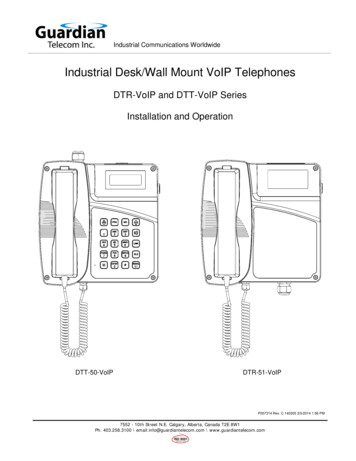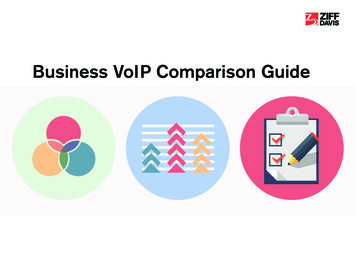
Transcription
Hosted VoIP:Comparison & Value PropositionJive Communications, Inc.866-768-5429www.getjive.com
Hosted VoIP: Comparison & Value Proposition1Introduction: Hosted Voice over IP (VoIP)Hosted Voice Over IP (VoIP) telephony is quickly becoming the standard communications platform fororganizations of all sizes. The wholesale shift from traditional telephone systems to feature-rich Hosted VoIPservice has already begun. Immediate cost savings is the most commonly cited benefit of adopting Hosted VoIP,along with increases in system reliability and worker productivity. This white paper explains some key differencesbetween different types of systems, and also outlines the significant value proposition presented by Hosted VoIP.Traditional Systems vs. Hosted VoIPThere are many telephone system options availableto institutions, each offering various levels of cost,flexibility, and control. Some of the more commonsystem types are described in Table 1.In the last few years, the choices of Analog PBX/Keyand Centrex systems have been transformed to useInternet Protocol (IP) instead of traditional Time DivisionMultiplexing (TDM). This transformation to IP-basedtechnology has created the On-premises IP PBX andHosted VoIP, which are rapidly gaining market share.hosted service, organizations realize financial savings,enjoy greater reliability, and experience enhancedproductivity.Financial SavingsFinancial savings is typically the primary benefitmentioned when discussing Hosted VoIP. The ability forinstitutions to save on both initial capital expendituresand ongoing operating expenses makes Hosted VoIPparticularly attractive. Hosted VoIPHosted VoIP ArchitectureHosted VoIP deployments require little on-premisesequipment—in most cases, needed equipment islimited to a high-quality router, Integrated AccessDevices (IADs), and IP telephones.Although analog phones can be used in some cases,IP telephones are strongly recommended becausethey enable more features, require less hardware,and are easier to use. IADs are primarily used to allowinstitutions access to their existing analog handsets,credit card machines, alarms, fax machines, etc.The Hosted VoIP Value PropositionHosted VoIP offers significant value over legacy voicesolutions. Table 2 summarizes the value offeredby each voice technology. By delivering voice as aFigure 1: Hosted VoIP Network Topology
Hosted VoIP: Comparison & Value y SystemsTraditional PBXs are telephone systems that serve one organization at onelocation. These systems reside on-premise and are owned and maintained bythe organization. Users share access to the trunk lines physically connected tothe PBX. Though feature-rich, Traditional PBX systems require a substantial cashoutlay and are cost-prohibitive for many organizations.CentrexCentral Office Exchange Service (Centrex) is an enhanced telephone serviceoffered by local phone providers. Institutions do not purchase a phone system,and no specialized hardware is required on-premise. Many disparate institutionsare served by the same Centrex equipment. Though less expensive than aTraditional PBX, Centrex does not offer the same level of features.On-premisesIP PBXAn On-premises IP PBX is similar to a Traditional PBX, but utilizes IP (InternetProtocol) as the transport mechanism. These systems allow organizations tocombine voice and data traffic on a single network, producing cost savings.Similar to Traditional PBX systems, there is significant up front cash outlayrequired, and organizations are responsible for maintenance.Hosted VoIPHosted Voice Over IP (VoIP) combines the best aspects of Centrex and Onpremise IP PBX systems. The provider owns and manages all necessaryequipment, and the service is delivered via broadband Internet access. HostedVoIP provides enterprise-grade features to many institutions on a scalablehardware infrastructure. Hosted VoIP is a cost-effective and feature-richtelephony solution.Table 1: Common Voice Technologiessolutions can be customized to fit current budgets andprojected growth requirements without forkliftupgrades. Hosted VoIP also provides excellent ROI andcost savings through increased staff efficiencies andtechnological effectiveness.It is hard to impossible to save money in the long termwith on-premises systems. The staffing, system upgradesand maintenance needed create an costly, ongoingexpense. By eliminating these costs, Hosted VoIPprovides a dramatically reduced total cost of ownershipto organizations. The consolidation traditional telecomexpenses with IT infrastructure in a Hosted VoIP solutiongives IT directors and facilities (M&O) management staffthe opportunity to focus on important site issues, ratherthan worrying about telephone system availability.Today’s budgets are tight and IT decision makers morethan ever are concerned with the financial impact oftheir communications solutions. Hosted VoIP can oftendeliver the greatest return for telecommunicationsbudgets.Low Capital RequirementsHosted VoIP has very low initial capital requirements,especially if a data network already exists. In particular,IP phones are the only capital expenditures necessaryin most cases. In comparison, Analog PBX and On-
Hosted VoIP: Comparison & Value PropositionFinancial SavingsLow capital requirementsStandards-based equipmentLow risk of obsolescenceConverged voice, data, and video linesOne provider, one numberUtilize stranded capacitySimplifies moves, adds, and changesPredictable monthly expensesNo payment until service onFlexible to organizational changesGreater ReliabilityProfessionally hosted voice infrastructureManaged class-of-service internet accessEnd-user controlDisaster recoveryLocal survivability via PSTN*Enhanced ProductivityCohesive services for distributed workforcesSupport for remote usersEasy rollout of new featuresMobile phone integration and applicationsEnd-user productivity featuresUnified Communications3PBX/KeyCentrexIP PBXHosted VoIPTable 2: Value Comparison of Voice Technologiespremises IP PBX technologies requires large capitaloutlay for the servers, the required phones, andexpensive maintenance and licensing contracts. Thesecosts often reach millions of dollars. For this reason,many institutions decide to avoid up front capitalintensive solutions and utilize a Hosted VoIP provider.Standards-Based EquipmentThe equipment necessary for Hosted VoIP is standardsbased, which means it can be easily reused orredeployed to work with other equipment that supportsthe same open standards. It also offers more flexibilityand equipment options from a variety of vendors,typically at lower costs. By contrast, On-premises IPor Analog PBX solutions typically have proprietaryequipment that can only be used with that particular
Hosted VoIP: Comparison & Value Propositionvendor’s equipment. This proprietary equipmentcannot be reused or redeployed in most circumstances,resulting in “vendor lock-in.” It also results in an inflexiblesolution with limited equipment choices and higherhardware prices.Low Risk of ObsolescenceTechnology changes at a rapid pace, and it is commonfor equipment to become obsolete quickly. Hosted VoIPreduces this risk in several ways. First, since the amountof necessary equipment is low, the risk also remains low.Second, the risk of obsolescence shifts to the HostedVoIP provider since they own and manage the voiceinfrastructure. Third, Hosted VoIP allows institutionsto grow or shrink their number of lines as theirorganization changes, without the risk of ‘outgrowing’the solution. As an organization grows, the same systemthey used with only 100 handsets can scale up to 10,000handsets or more.Converged Voice, Data, and Video LinesThe merging of multiple networks down to oneconverged network can save on the number ofnecessary access lines and subsequent maintenancecosts. In many cases, current voice traffic and data trafficutilize two separate internet access lines—one for voiceand another for data. After merging the two networks,one of those access lines can typically be dropped,used solely for backup purposes, or combined to allowmore bandwidth on the single converged network. Ineither case, access costs will be lowered or availablebandwidth will increase. This is true for all types of datatransport service including DSL, Cable, T1, DS3, fiber, etc.This benefit is especially pronounced when HostedVideo is deployed. Rather than purchasing dedicatedISDN or similar connections solely for the videoequipment, the converged network can be leveragedto provide connectivity on an “as-needed” basis. When4no video is being used, this bandwidth is available to beused for other network activities.Utilize Stranded CapacityIn certain circumstances, converging voice and datacan assist in eliminating “stranded” capacity—meaningcapacity that is not being consistently utilized and istherefore wasted. Adding voice onto an existing internetaccess line will increase the traffic over the connectionand utilize the stranded capacity. This makes theexisting infrastructure more cost effective.Internal Cable InfrastructureExisting voice and data networks are separate in manydistricts. Voice is transported over traditional Cat 3 whiledata is on an IP network. Organizations are looking toconsolidate and transmit both voice and data over asingle physical network to decrease costs and increaseoptions. Voice, video and data consolidation on a singlephysical network provides many benefits to supportstaff by reducing operational costs, maximizing efficientuse of network resources and providing a flexibleplatform. These capabilities are important for adaptingto a constantly evolving, unpredictable, and increasinglycompetitive communications landscape.One Provider, One NumberHosted VoIP allows institutions to receive both voice anddata service from one service provider, with one numberto call for both questions and support. This helps tosimplify the support process and reduce the number ofnecessary support personnel.Simplified Moves, Adds and ChangesSome of the biggest telecommunications expensesincurred by organizations are generated as a result ofmoves, adds and changes (MACs) to their phone system.Traditional phone systems require intensive effort every
Hosted VoIP: Comparison & Value Propositiontime an employee moves offices or locations, often bythird parties that charge hourly or per-visit fees. HostedVoIP simplifies this process, allowing these changesto be quickly and easily performed by the enterpriseadministrator through a point-and-click web-basedinterface. Many changes can be accomplished by endusers themselves. MACs in a Hosted VoIP environmenttake just seconds, are completed in real-time, and donot require any budget expenditure.No Payment Until Service Is OnWith Hosted VoIP, monthly service charges are typicallynot billed until the service is turned on and fullyfunctional. This provides additional flexibility to theorganization with regard to the start-of-service date,and reduces wasted spending due to duplicate services.Moves, additions, and changesin a hosted VoIP environmenttake just seconds and do notrequire specialized techniciansor per-incident service charges.Predictable Monthly ExpensesHosted VoIP allows organizations to know exactly whattheir telecommunications costs will be each month.There are no unexpected costs associated with softwareupgrades, licensing, or hardware maintenance. Inaddition, local and long-distance calling are typicallyincluded with the service, without any per-minutecharges. This makes monthly budgeting predictable andeasy.5Flexible Organizational ChangesToday’s workforces are constantly growing andshrinking—creating problems when using traditionalphone systems. Legacy solutions may not easily expandor contract if the workforce changes over time. HostedVoIP services allow institutions to buy only whatthey need, with the ability to add or remove lines asnecessary. Organizations only pay for the number oflines needed at any given time. Associated configurationchanges are also provided at no charge.Greater ReliabilityThe ability to communicate is a critical element ofsuccess. For this reason, voice reliability cannot becompromised. Hosted VoIP has been engineered withthis in mind. In fact, Hosted VoIP has distinct reliabilityadvantages over both traditional voice and on-premisesIP PBX services.Professionally Hosted Voice InfrastructureFew organizations would consider themselvesexpert data center operators. But On-premises PBXsolutions require organizations to do just that—hosttheir own phone system at their own location, andat their own expense. If something goes wrong, theorganization is responsible for correcting the error.Given the importance of communication, this createsa large burden on the institution to be prepared forthe unexpected.In contrast, Hosted VoIP relieves the institution of thisresponsibility. Since the phone service provider ownsand manages the server equipment, it is responsible forits upkeep. It is much more cost-effective for the serviceprovider to hire experienced IT managers and datacenter operators because they can spread the expenseacross a much larger user base than any one customercould.
Hosted VoIP: Comparison & Value PropositionManaged Class-of-Service Internet AccessA select group of Hosted VoIP providers offer managedclass-of service internet access. This access refers to theactive prioritization of voice and video over other typesof network traffic. When this type of internet access isoffered by the provider as part of the service package,the institution can be confident that voice quality will bemaintained even during periods of network congestion.Disaster RecoveryUsers of Hosted VoIP have a variety of disaster recoveryoptions. In the event of fire, earthquake, severe weather,or even a simple failure of their internet access lines,users have the ability to reroute all calls to wirelessnumbers, a home phone or a third party answe
the PBX. Though feature-rich, Traditional PBX systems require a substantial cash outlay and are cost-prohibitive for many organizations. Centrex Central Office Exchange Service (Centrex) is an enhanced telephone service offered by local phone providers. Institutions do not purchase a phone system, and no specialized hardware is required on-premise. Many disparate institutions











